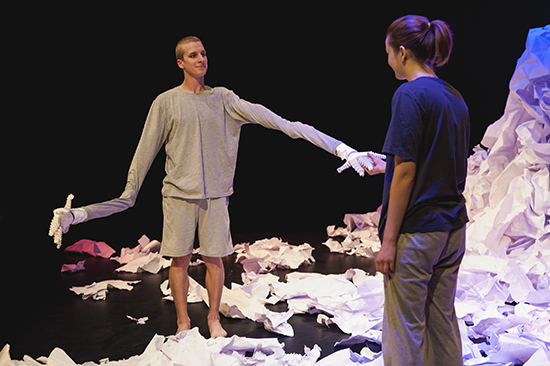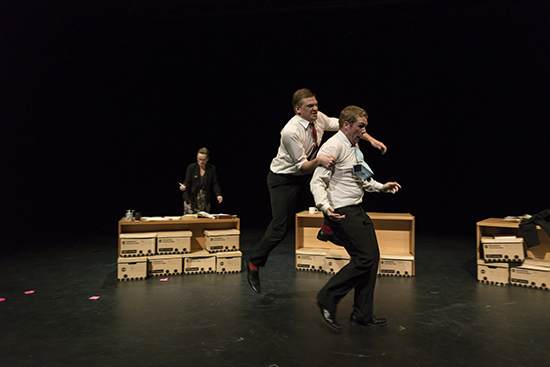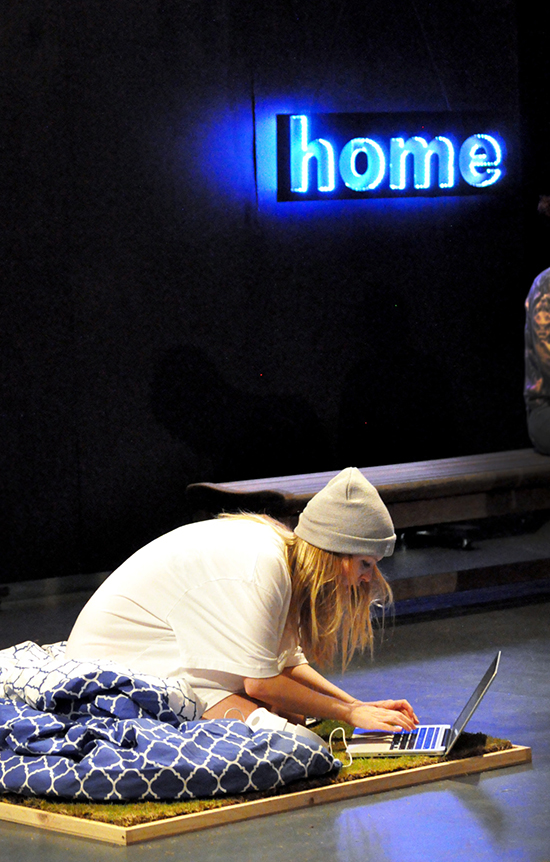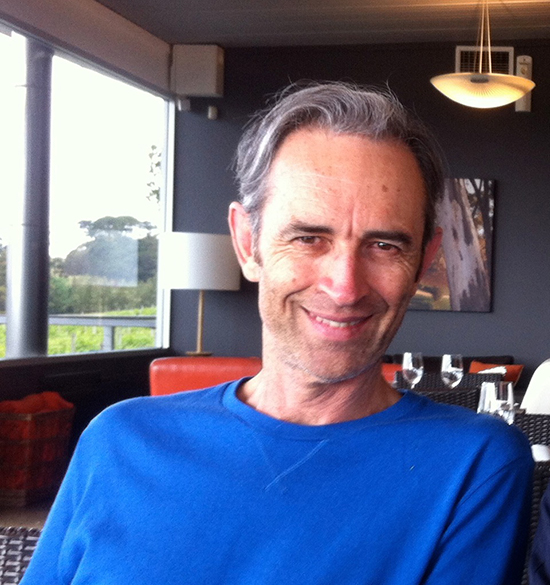 |
ACA students Lachlan Scown, Evie Leonard in Dreamers, 3D’15 photo Sofia Calado Photography |
Established in 2001 and centrally located in Light Square, just west of the city centre, TAFE SA’s Adelaide College of the Arts is unique in being Australia’s only tertiary institution where performance, visual arts and design are taught in a single, purpose-built facility (sadly, the Advanced Diploma of Professional Writing—which this writer completed in 2011—has been discontinued as of this year). While there is an increasing focus on online courses, a State Government-funded $3.82 million expansion announced in August will see the relocation to the city campus of the music and sound production programs from TAFE SA’s Salisbury campus. Students studying graphic design, digital media and game art development at the Tea Tree Gully campus will also transfer to Light Square as part of the expansion.
The College’s Advanced Diploma of Arts (Acting) is a three-year, full-time actor-training program that covers four broad disciplines: acting, movement and voice, performance/production and contextual studies. Originally introduced at the Centre for the Performing Arts (CPA) in Grote Street—one of two institutions, along with the visual arts-focused North Adelaide School of Arts (NASA), folded into the new college in 2001—the acting course was established by David Kendall in 1986. It is now overseen by Head of Acting Terence Crawford, one of three core members of staff alongside voice specialist Simon Stollery and movement lecturer Jenn Havelberg. Graduates of the course include Nathan O’Keefe (who has worked with Slingsby, Windmill, SA State Theatre Company and Bell Shakespeare), Renato Musolino (Windmill, STCSA, The Other Ones). Kate Cheel (Windmill, STCSA, Kneehigh), Nathan Page (theatre, film and television, including Miss Fisher’s Murder Mysteries) and Rory Walker (STCSA, Brink, Slingsby, Windmill and more). During my conversation with Crawford, he nominated three further graduates as exemplars of the course: Josie Were (multidisciplinary performer Crack Theatre Festival, Vitalstatistix, STCSA; trained with SITI in NYC and Philippe Gaulier in Paris), Matilda Bailey (STCSA) and Charles Sanders (STCSA; Artistic Director Early Worx; trained with SITI). All, while still young, have since returned to the college in various teaching and leadership roles.
In the cultural centre
I begin by asking Crawford to contextualise his approach to teaching at the College within a career that saw him graduate as an actor from NIDA in 1984 and subsequently take on Head of Acting roles at Western Sydney’s now-defunct Theatre Nepean and, in Singapore, TTRP (since renamed Intercultural Theatre Institute) and LASALLE College of the Arts. “The thing I recognised immediately about Adelaide—and I’ve been in this job for eight and a half years now—is that we’re in a little city square in a little city, where the cultural industry happens around us, so my determination from the beginning was to make sure that this place was thought of as part of that broad industry.”
 |
ACA students Lucy Sutherland, Jack Sumner, Patrick Klavins in Mouth Machine, 3D’14 photo Sofia Calado Photography |
The advantages of distance
Crawford compares the relative isolation of Adelaide and its lack of proximity to the cultural centres of the eastern states with that of Theatre Nepean—“50 kilometres into the bush away from Sydney and NIDA”—but believes this can also work to the city’s advantage. For a start, he says, “If you make mistakes, you’re not making them in the glare”—a sentiment echoed by 2010 graduate Charles Sanders, who is in mid-rehearsal for a production of Brecht’s Mother Courage and Her Children by the College’s acting, design and technical production students. “One of the really nice things about working in Adelaide, and especially inside this building,” Sanders tells me over coffee, “is that you’re removed to some extent from the east coast industry, which is very competitive and not particularly good at allowing people to fail or take big risks.”
Crawford expands on this theme: “The great benefit of studying the arts in Adelaide, reflective of the great benefit of being an artist in Adelaide, is a sense of community. Our students don’t feel they have to cower at the thought that Geordie Brookman [Artistic Director of State Theatre Company of South Australia] is going to come and see their grad show; they’ve already met and worked with him because he’s part of the program.”
The teaching-directing mix
Sanders, fresh from completing a Masters of Directing at NIDA, has been added to what Crawford calls his “Lazy Susan” of directors—a rotating roster of industry professionals employed on a casual or part-time basis to undertake a mix of teaching and directing commitments—that also includes Brookman, Jon Halpin, David Mealor, Chris Drummond, Elena Carapetis and Corey McMahon among others. Under their tuition, second- and third-year students keep to an intense schedule of rehearsing four shows a year, and a final year that culminates in a self-devised project, 3D, and an industry showcase that incorporates a graduate show. Sanders describes these guest directing gigs as “three-quarters directing and one-quarter teaching or two-thirds directing and one-third teaching,” contrasting this division of time and energy with that of fellow graduates Josephine Were and Matilda Bailey. “Matilda’s focus is on voice,” Sanders tells me, “so she comes in at more of a pure teaching level, whereas Josie probably has something like a 50/50 split between directing and teaching duties.”
Bailey will be taking up a casual teaching post as of October, after having completed a course of study in voice at London’s Central School of Speech and Drama. Although still in her 20s, the role will be a homecoming for Bailey in more ways than one: in addition to being a guest lecturer in voice at first- and second-year levels, she will also be teaching an evening course that will have as its initial focus the preparation of aspiring actors for drama school auditions. “It was at a short course similar to this,” Bailey tells me by email, “that I first discovered AC Arts and began my journey to being an actor. The idea of being a mentor makes me feel somewhat embarrassed as I still feel I have much to learn. However, Adelaide’s isolation makes it even more integral for practitioners who have pursued further studies overseas to bring that learning back with them.”
Josephine Were, who graduated in 2009, has also spent a significant amount of time away from Adelaide, undertaking training in Suzuki and Viewpoints with New York’s SITI Company and Le Jeu and Clown with Ecole Philippe Gaulier in Paris. “I view mentoring as a two-way relationship,” Were writes in an email. “I have had and continue to have some brilliant mentors in my life. These are people who have given me the energy and time to play, talk, share and dream without fear of failure. I try to carry this philosophy too. It’s always exciting how the process of trying to mentor others causes you to further distill ideas and questions for yourself too. So it’s very much an exchange.” As to her specific role at AC Arts, Were states, “I often mentor the 3D project, which is a relaxed, provocateur-like relationship over one term. I also teach the first years for a unit of performance skills in which I lead them through games and tasks based around play, listening and ‘being together,’ which draws heavily on my Gaulier training.”
Were also directed a devised show, HOME, by 2014’s second-year class, a production that Crawford recalls with typically generous praise: “This kind of gig is one I’ve been programming for about six or seven years, a moment when students are led by a theatre-maker in the devising of something as a stepping stone to the genuinely group-devised piece that they do in third year. And Josephine did an extraordinary piece that was thoroughly owned by the actors, and very humanely and directly shared with its audience. All three of these people are very special talents.”
 |
HOME, devised theatre performance with 2nd and 3rd year theatre ACA students lead and directed by Josie Were photo Molly Stanley |
The actor: dramaturgical & Stanislavskian
As Crawford reflects on nearly 30 years of being an actor-teacher, he nominates two pedagogical interests that have been key to what he calls the “last chapter” of his teaching career: the development of, in his phrase, the “dramaturgical actor—an actor for whom writing and acting are symbiotic”—and furthering a conversation around the aesthetics of performance that doesn’t reject the Stanislavskian acting tradition. It remains to be seen whether Crawford’s successors will pick up and run with these particular balls, but planning for the future is clearly on his mind.
Legacy, succession, change
Crawford tells me, “I think important institutions have fallen into major holes because there have been long periods of neglect in relation to succession planning and I’m determined that that doesn’t happen—not just for this institution but for the whole sector. Because there are so few of these jobs, and while it’s an incredible privilege to have one, I think you owe it to the world not to cling to it but to share all the knowledge you can and to make sure there’s a whole load of people who are the next generation of teachers.”
And can he see that next generation starting to take shape? “Put it this way,” he says, jabbing a finger towards the College’s third floor, “there are three offices up there that are occupied by me and two other outstanding performance teachers, Simon Stollery and Jenn Havelberg. If in five or 10 years those three offices are occupied by the three graduates we’ve been talking about today, it will be an amazing course; very different, but I would be excited for the future of South Australian theatre training. That would be a dream. They might even employ me occasionally!”
 |
Terence Crawford photo courtesy Adelaide College of the Arts |
TAFE SA Adelaide College of the Arts
RealTime issue #134 Aug-Sept 2016 pg.
© Ben Brooker; for permission to reproduce apply to [email protected]








 back
back